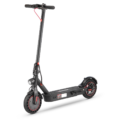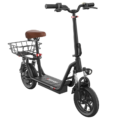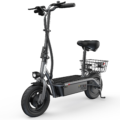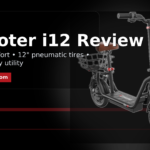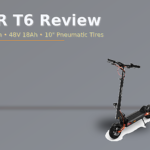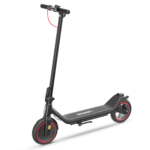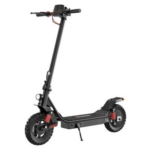- Home
- Scooters
- Electric Scooters
- iScooter iX3
iScooter iX3
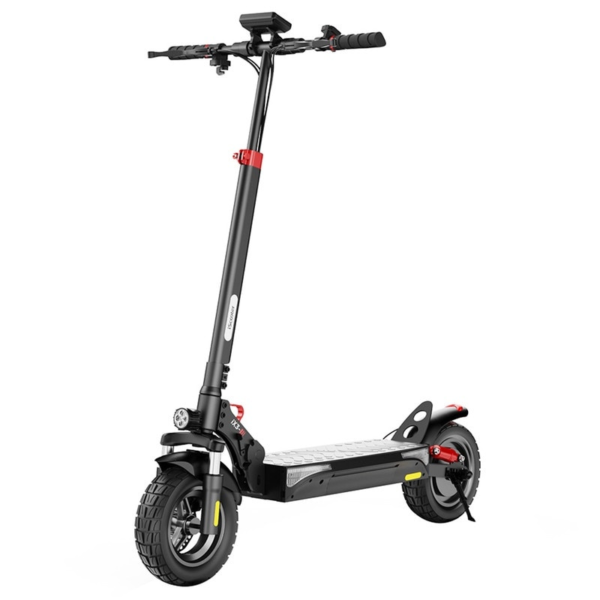


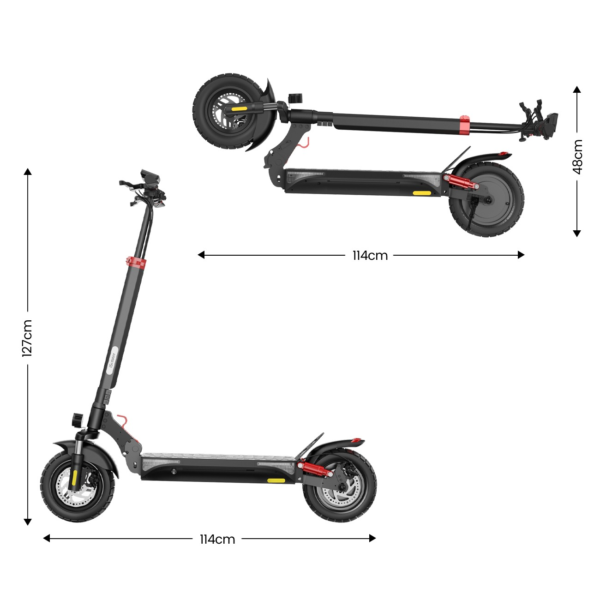
- Battery Range: 25 miles (40 km)
- Top Speed: 24 mph (40 km/h)
- Motor Power: 800 W rear hub
- Weight Capacity: 264 lb (110 kg)
- Charging Time: ~6–7 h
- Scooter Weight: 52.2 lb (23.3 kg)
PROS
- 10″ off-road pneumatic tires
- Dual mechanical discs + electronic brake
- IPX4 water resistance
- App monitor via Bluetooth
- Turn signals and E-MARK reflectors
CONS
- Single-motor rear-wheel drive
- Range limited to ~25 miles (40 km)
- No NFC lock

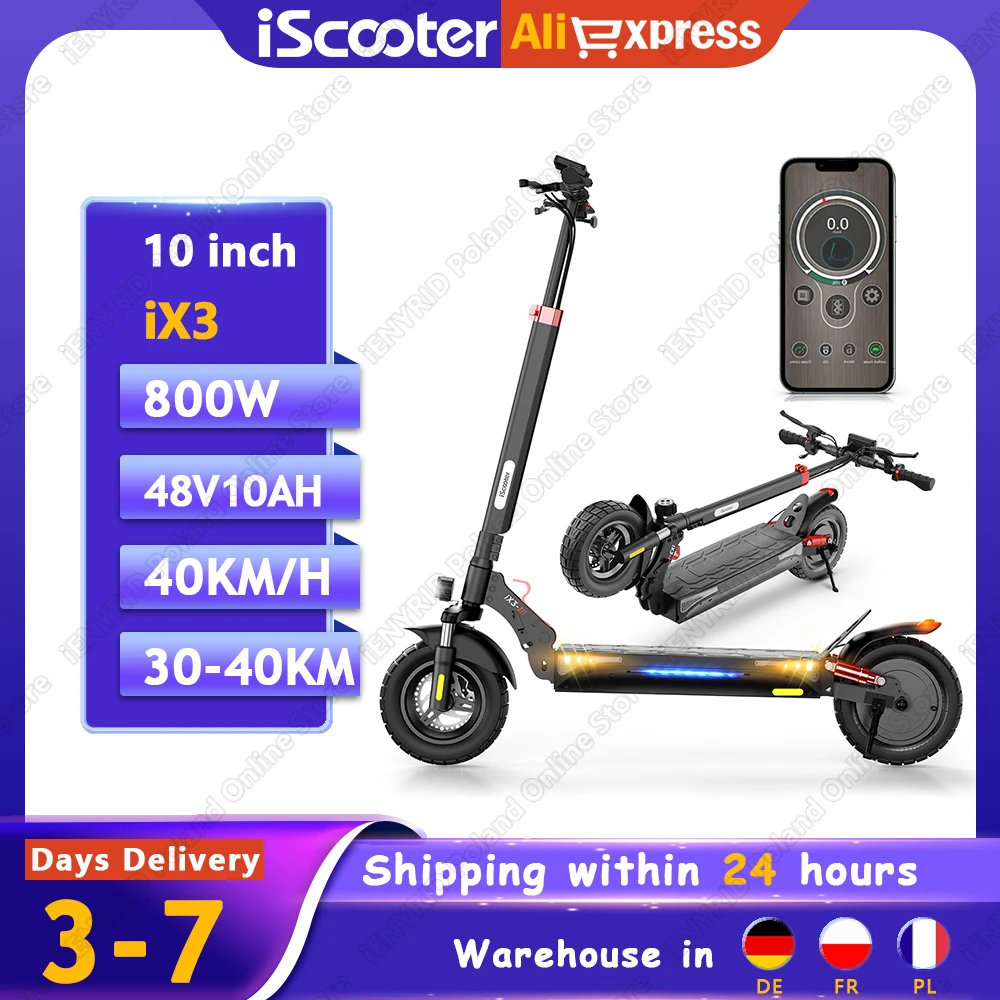




Table of contents
- What Is the iScooter iX3?
- How the iScooter iX3 Works
- Key Specifications (clean table)
- Design & Build Quality
- Performance Fundamentals
- Battery, Range & Efficiency
- Ride Quality & Comfort
- Braking & Safety Features
- Portability & Daily Usability
- Maintenance & Care
- Weather & Seasonal Considerations
- iScooter iX3 vs Alternatives
- Who the iScooter iX3 Is (and Isn’t) For
- FAQs
- Glossary
Looking for a compact, beginner-friendly electric scooter for predictable daily rides? The iScooter iX3 fits the bill. It pairs a practical hub motor with a commuter-sized battery and no-flat tires in a simple folding frame. For context, if you want a step up in power, the iScooter i10 Pro sits higher in the lineup; however, the iX3 keeps weight and upkeep low for everyday city travel.
What Is the iScooter iX3?
The iScooter iX3 is an entry-level, city-focused electric scooter designed for short to medium urban trips. Rather than chase headline numbers, it prioritizes control, portability, and day-to-day reliability. Consequently, you get a compact aluminum chassis, a moderate-power rear hub motor, and a battery sized for routine errands and commutes. Moreover, because it folds quickly and weighs far less than dual-motor machines, it suits riders who mix scooters with buses, trains, or rideshare legs.
Additionally, the iX3 emphasizes worry-free use: 8.5-inch honeycomb solid tires that shrug off flats, a combined mechanical and electronic brake for progressive stopping, and integrated LED lighting for visibility. Meanwhile, a clean handlebar display and basic app functions—such as cruise control and ride modes—round out a package built for repeatable everyday travel rather than occasional speed runs.
How the iScooter iX3 Works
At its core, the iX3 links a brushless rear hub motor to a 36-volt electrical system and a thumb throttle. In simple terms, the system turns your right-hand input into smooth, metered acceleration while protecting the battery and controlling speed.
- Motor: The rear-hub brushless motor sits inside the wheel, so there are no external chains or belts to adjust. Consequently, power flows directly to the ground with little mechanical loss. Because of that layout, noise stays low and maintenance stays simple.
- Controller: The controller acts like a traffic cop. It meters current from the battery to the motor based on throttle input and selected mode. Furthermore, it manages protective functions—low-voltage cut-off, over-current limits, and electronic braking—so the scooter behaves consistently even as conditions change.
- Battery: A 36 V lithium-ion pack stores ride energy. Its capacity sets the broad outline of range; however, terrain, temperature, rider weight, and speed ultimately determine real-world distance. Notably, the battery’s protections help prevent over-charge, over-discharge, and short-circuit events.
- Throttle: A thumb lever sends a signal to the controller. Press lightly for cruising or firmer for brisk acceleration. Plus, selectable modes cap top speed and tune response, which helps beginners learn at a comfortable pace.
- Brakes: The system blends electronic regenerative braking with a mechanical rear disc. Initially, regen provides gentle deceleration; then, the disc brake adds firm bite as you pull farther. Therefore, you feel a smooth ramp from early scrub to committed stopping.
Together, these parts create a predictable, repeatable ride. Simply power on, select a mode, kick to start, and roll on the throttle. Because the system is integrated, daily tweaks are rare beyond occasional fastener checks and routine cleaning.
Key Specifications (clean table)
Values are shown in US units first with metric in parentheses. Minor regional variations may exist.
General
| Item | Value |
|---|---|
| Model | iScooter iX3 |
| Intended use | Urban commuting / last-mile |
| Wheel size & type | 8.5 in honeycomb solid tires (no-flat) |
| Frame material | Aluminum alloy |
| Drive | Rear-hub brushless motor |
| Water resistance | IP54 (splash resistant) |
| Max rider load | 264 lb (120 kg) |
| Scooter weight | ~27.6 lb (12.5 kg) |
| Unfolded dimensions (L×W×H) | ~42.5 × 17 × 45 in (108 × 43 × 114 cm) |
| Folded dimensions (L×W×H) | ~42.5 × 17 × 18.9 in (108 × 43 × 48 cm) |
Performance & Power
| Item | Value |
|---|---|
| Nominal motor power | 350 W |
| Peak output (approx.) | ~700 W |
| Top speed (mode-limited) | 15.5 mph (25 km/h) |
| Typical climb | Short hills up to ~15% (rider-dependent) |
| Riding modes | 3 modes (eco/standard/sport) |
Battery, Charging & Electrical
| Item | Value |
|---|---|
| Battery voltage | 36 V |
| Battery capacity | 7.5 Ah (270 Wh) |
| Charger output | 42 V DC |
| Charge time | ~4–5 hours from low to full |
| Battery protections | Over-charge, over-discharge, short-circuit, over-current |
| Display / controls | Handlebar LED display, power/mode button |
| App features | Bluetooth pairing, mode selection, cruise control toggle, lock |
Build & Dimensions
| Item | Value |
|---|---|
| Deck length × width | ~17.7 × 5.9 in (45 × 15 cm) usable |
| Handlebar height from deck | ~45 in (115 cm) |
| Ground clearance | ~3.5 in (9 cm) |
| Folding mechanism | One-step lever with latch |
Safety & Control
| Item | Value |
|---|---|
| Brake system | Rear mechanical disc + electronic (regen) |
| Headlight | Integrated LED |
| Tail/brake light | Integrated LED with brake signal |
| Reflectors | Front/side/rear reflectors |
| Bell | Handlebar bell |
Features & Extras
| Item | Value |
|---|---|
| Cruise Control | Yes (app-toggle and/or hold-throttle activation) |
| Kick-to-start | Yes |
| Speed-limited modes | Yes |
| Stand | Integrated side kickstand |
Warranty & Compliance
| Item | Value |
|---|---|
| Warranty (typical) | 12 months scooter; 6 months battery/charger (region-dependent) |
| Compliance | CE, RoHS, FCC (region-dependent) |
| Legal note | Local speed and road-use rules vary by area |
Design & Build Quality
The iX3’s chassis aims for durability without extra weight. Consequently, the aluminum frame resists corrosion while staying light enough to carry upstairs. Because the motor hides inside the rear wheel, the deck remains uncluttered and rigid, which steadies steering feel. In addition, the deck’s grippy surface resists slippage with wet-soled shoes, and the usable length supports common stances.
Furthermore, the stem locks into a straightforward folding base. When adjusted correctly, the latch resists play and stays quiet. You may notice a hint of flex if you rock the bar while stationary; however, once rolling, the structure feels composed. Meanwhile, the cockpit keeps controls within easy reach: a central LED display, a thumb throttle, a brake lever, and a bell. As a result, you seldom shift hand position to operate anything.
Fit-and-finish sits solidly in the commuter class. Wires route through molded guides, connectors use simple seals, and plastic shrouds protect the hinge area. Additionally, standard metric hex fasteners make periodic checks quick. Because the folded stem latches easily to the deck, one-hand carrying becomes natural after a few tries.
Performance Fundamentals
Acceleration feel
From a standstill, the iX3 uses kick-to-start for safety. Then, in eco mode, acceleration feels gentle and predictable. In standard mode, the response grows a touch brisker. Finally, in sport mode, the scooter provides the most assertive roll without feeling jumpy. Consequently, you can choose a mode that matches your route and confidence. Moreover, mid-throttle response stays linear, so holding a set speed soon becomes second nature.
Cruising stability
At typical city speeds, the chassis tracks straight and calm. Although 8.5-inch solid tires ride firmer than air-filled options, they deliver consistent feedback and zero puncture drama. Therefore, you can plan routes without worrying about glass or thorns. Additionally, the moderate deck height keeps your center of gravity reasonable, which aids stability through gentle curves and lane changes. Even over painted lines or shallow cracks, the iX3 remains composed when you keep your knees slightly bent.
Hill-climb behavior (~7–10% grades)
On rolling neighborhoods, short 7–10% grades are manageable. Enter with moderate momentum; then keep the throttle steady in standard or sport mode. Admittedly, speeds will drop on longer or steeper sections, which is typical for a 350-watt class motor. Nevertheless, with planning—and by favoring switchbacks over direct ascents—you can preserve pace and efficiency. In practice, the iX3 rewards smooth inputs more than hard surges.
Battery, Range & Efficiency
Rated vs real-world range
Given its 270 Wh battery, the iX3 targets light-commute distance. Under mixed riding with an average-weight adult, many riders see about 12–18 miles (19–29 km). Naturally, steady eco-mode cruising on flat paths yields the upper end; conversely, frequent full-throttle starts, hills, and headwinds pull it toward the lower end. Importantly, that spread is normal across this class.
Factors that change range
- Rider weight: Heavier riders draw more energy for starts and climbs; lighter riders draw less.
- Terrain and wind: Hills and headwinds increase electrical load; tailwinds and flats reduce it.
- Temperature: Cold weather reduces available energy; warm, moderate weather improves it.
- Speed and stops: Higher average speed and frequent stops burn watt-hours faster.
- Tires and surface: Solid tires offer consistent rolling resistance; however, rough pavement still adds drag.
Charging best practices
First, charge at room temperature whenever possible. Second, avoid full charges if storing the scooter for weeks; around 50–60% is kinder to the pack. Third, use only the supplied or approved 42 V charger. Additionally, after wet rides, wipe the scooter dry and ensure the charge port is free of moisture before plugging in. Finally, place the charger on a hard surface with ventilation during use.
Ride Quality & Comfort
Because the iX3 uses honeycomb solid tires, it can’t get flats, and it doesn’t need pressure checks. However, the ride feels firmer than with pneumatic tires on rough roads. Therefore, slightly adjust your technique: bend knees over broken pavement, unweight the deck over deep cracks, and keep elbows relaxed to absorb chatter. In return, you gain consistency and low upkeep.
Ergonomically, the deck supports a natural stance for most adults. For instance, angle the front foot slightly and place the rear foot diagonally to stabilize hips and shoulders. Meanwhile, the handlebar height suits average torsos; taller riders can fine-tune comfort by shifting foot placement and keeping a soft bend in the elbows. Although a trace of stem flex can appear over sharp impacts, it remains controlled at city speeds.
Braking & Safety Features
The iX3 combines electronic regen with a mechanical rear disc. Initially, light lever pressure triggers regen, which slows the wheel smoothly. Then, as you pull farther, the disc brake adds stronger mechanical bite. Consequently, the feel ramps up predictably from early scrub to committed stopping. On slick surfaces, modulate pressure and brace with your core to preserve traction.
Lighting covers both seeing and being seen. The headlight projects a forward beam suitable for lit streets and moderate pace. Simultaneously, the rear light brightens under braking, which alerts traffic behind you. Side and rear reflectors increase cross-traffic visibility. Furthermore, the handlebar bell provides a quick audible cue for pedestrians. With IP54 splash resistance, the scooter tolerates damp roads and light rain; however, you should avoid submersion, standing water, and power-washing.
Portability & Daily Usability
At roughly 27.6 lb (12.5 kg), the iX3 is reasonable to carry up a flight of stairs. Because the folding latch engages quickly, you can fold, latch the stem to the deck hook, and lift by the bar in one fluid motion. Consequently, it fits under many desks, behind bus seats, or in sedan trunks. Moreover, solid tires let you roll across alley debris without puncture anxiety.
For storage, keep it indoors at moderate temperatures. Additionally, use the kickstand on level ground and point the scooter uphill on crowned streets to reduce roll-away risk. As for security, treat it like a bicycle: use a quality lock through the frame opening and choose visible, populated spots. Since it’s light enough to lift, physical locking remains essential.
Maintenance & Care
A short, consistent routine pays off:
- Weekly (or every 30–40 miles / 50–65 km):
Wipe down the scooter; then check the folding latch tension and brake lever feel. Spin both wheels to confirm nothing rubs and the rotor runs true. - Monthly:
Inspect brake pad thickness and caliper alignment. Next, verify hinge bolts, handlebar clamps, and caliper mounts for snugness with a hand tool. Also, scan cable sheathing for wear where it meets the frame or hinge. - Quarterly:
Open the app to check for firmware updates; afterward, apply only if release notes are relevant. Clean connector caps and look for moisture traces after rainy weeks. If range seems off, balance-charge by letting the pack reach 100% and remain on the charger 30–60 minutes (occasionally). - Tires:
Solid tires remove pressure checks; nevertheless, inspect tread for cuts, embedded grit, or honeycomb cracking. Replace when tread blocks round over. - Brakes:
Pads last long on commuter scooters. Replace when compound thins toward the backing plate or when persistent squeal survives cleaning and alignment. - Storage:
For multi-week storage, leave the pack around 50–60% and top off monthly. Avoid hot cars and freezing garages, since extremes degrade cells.
Weather & Seasonal Considerations
Rain
IP54 protects against splashes, not immersion. Therefore, slow down on wet paint, metal plates, and leaf-covered patches. Brake earlier, straighten before corners, and avoid puddles that can hide potholes. Afterward, dry the scooter, open the charge-port cap to check for droplets, and wait until it’s fully dry before charging.
Heat
High ambient heat stresses batteries and controllers. Consequently, park in the shade, avoid charging in hot trunks, and consider easing pace on sweltering days. If the deck feels very warm after a ride, allow it to cool to room temperature before charging.
Cold
Below ~50 °F (10 °C), range declines and rubber hardens. Thus, expect shorter trips and allow extra braking distance. Starting indoors helps both rider and scooter; then ride smoothly to keep power draw efficient. After cold rides, let the scooter warm to room temperature before you plug in.
iScooter iX3 vs Alternatives
Where the iX3 excels
- First scooter / beginners: Predictable power and simple controls shorten the learning curve.
- Short urban hops: Daily totals around 2–8 miles (3–13 km) suit its battery.
- Multi-modal commutes: Quick folding and low weight simplify train and bus transfers.
- Flat-tire avoidance: Solid tires remove a common point of failure and maintenance.
Where a different class may fit better
- Longer distances: One-way commutes beyond ~15 miles favor larger batteries.
- Hilly routes: Frequent, extended 10–15% grades call for higher-power motors.
- Rough pavements: Pneumatic tires or suspension frames boost comfort on broken roads.
- Faster corridors: If local infrastructure supports higher speeds, a scooter with a higher limiter may match flow better (always within local rules).
Who the iScooter iX3 Is (and Isn’t) For
The iX3 suits commuters, students, and last-mile riders who want low fuss and predictable manners. In particular, it works well for urban errands, campus travel, and trunk-to-destination hops. Because it folds fast and weighs modestly, it slots into a typical weekday without much thought. With modest route planning, moderate hills remain manageable.
Conversely, riders seeking long weekend loops, plush comfort at speed, or sustained hill pace should consider scooters with bigger batteries, pneumatic tires, or suspension. Likewise, heavier riders who demand strong hill performance may prefer a motor with more headroom. These choices reflect deliberate trade-offs: portability and simplicity over outright power. Notably, those trade-offs keep upkeep low while meeting the core brief.
(Usage note: The specifications favor everyday practicality, so expect reliable starts, consistent braking, and low-drama transport rather than raw speed.)
FAQs
1) How fast does the iScooter iX3 go?
Top speed is about 15.5 mph (25 km/h) in the highest mode. Therefore, it aligns with common urban limits and keeps control predictable.
2) What real-world range should I expect?
Most riders see roughly 12–18 miles (19–29 km), depending on speed, stops, hills, temperature, and rider weight. Consequently, gentle eco-mode cruising stretches the distance, whereas fast riding shortens it.
3) Can the iX3 climb hills?
Yes, within reason. Short 7–10% grades are workable, especially in sport mode. However, extended steep climbs will slow any 350-watt class scooter.
4) Does it have cruise control?
Yes. After holding a steady throttle for several seconds, cruise can engage. Additionally, you can usually toggle it in the app.
5) What tires does it use, and do they get flats?
It comes with 8.5-inch honeycomb solid tires. As a result, they do not puncture or need air. Nevertheless, they ride firmer than pneumatic tires.
6) How should I charge and store the battery?
Charge at room temperature, avoid extreme heat or cold, and store around half charge for multi-week breaks. Moreover, let the scooter dry completely after wet rides before charging.
7) Where can I find an “iScooter iX3 overview” in one place?
Right here. This page brings together the design, power system, battery behavior, safety features, and care tips for quick reference.
Glossary
- Ah (amp-hours): Battery capacity; higher Ah indicates more stored charge.
- Wh (watt-hours): Battery energy (volts × amp-hours); the clearest single metric for range potential.
- Controller: Electronic module that meters battery current to the motor and coordinates protections.
- Regen (regenerative braking): Electronic braking that slows the wheel with the motor and recovers a small amount of energy.
- Stem flex: Elastic movement in the steering column; a little can smooth chatter, but excessive play needs attention.
- IP rating (Ingress Protection): Code for dust and water resistance; IP54 resists splashes but not immersion.
- Hub motor: Motor integrated into the wheel hub; it’s compact, quiet, and low maintenance.
- Kick-to-start: Safety feature requiring a push before the throttle activates, preventing accidental take-offs.
- Peak power: Short-burst maximum output useful for starts and brief climbs.
- Nominal power: Sustained output a motor can handle under normal conditions.
- Solid tire (honeycomb): Airless tire with internal cavities that add compliance and prevent flats.
- Pneumatic tire: Air-filled tire that improves comfort and traction but can puncture and needs pressure checks.
- Riding modes: Presets that cap speed and alter throttle response (eco/standard/sport).
- Mechanical disc brake: Cable-actuated caliper and rotor that provide firm, consistent stopping force.
- Charge cycle: One full discharge and recharge; partial cycles add up over time.
- BMS (Battery Management System): Circuitry that protects cells and helps keep the pack balanced.
Final Notes on Fit and Use
Choose the iX3 if you value simplicity, reliability, and portability. It provides a calm, confidence-building ride for urban corridors, campus paths, and short commutes. While it won’t match high-power machines on steep, sustained climbs or long-distance loops, it excels as a daily tool. Therefore, treat the folding latch and brake checks as routine, and the scooter will repay you with consistent performance and minimal downtime.
By understanding how the motor, controller, and battery work together—and by following the care schedule—you’ll extract more from every watt-hour. In short, ride attentively, brake early, and plan routes that play to the scooter’s strengths. With those habits, the iScooter iX3 becomes a dependable part of your mobility toolkit.
Specifications
General
| Model The Model specifies the exact version or name of the scooter. It helps identify its unique design, features, and specifications within the manufacturer’s product line. Knowing the model makes it easier to compare options, find compatible accessories, or look up support information. | iScooter iX3 |
| Brand The Brand identifies the manufacturer or company that designs and produces the scooter. A trusted brand is a sign of quality, reliability, and good customer support. Well-known brands often have higher standards for safety, performance, and after-sales service, giving you more confidence in your purchase. | iScooter |
| Release Date The Release Date indicates when the scooter model was officially launched on the market. This helps you know how current the design, technology, and features are. A newer release date often means updated components, improved performance, and the latest safety or smart features. | 17 November 2025 |
| Recommended Age Recommended Age indicates the minimum age range that the scooter is designed for, based on safety, size, and ease of use. Following the recommended age helps ensure that riders can handle the scooter’s speed, weight, and controls comfortably and safely. Always check local laws and use protective gear, especially for younger riders. | 16+ |
Performance & Power
| Motor Power (Wattage) What it means: The motor power, measured in watts (W), shows how strong the scooter’s electric motor is. Why it matters: Higher wattage usually means better acceleration, more torque, and improved performance on hills or rough terrain. For example, a 250W motor is good for flat city roads and light riders, while a 500W or 1000W motor provides more power for faster speeds or climbing steep inclines. | 800 W rear hub (max power) |
| Top Speed The Top Speed indicates the maximum speed that the scooter can reach under optimal conditions. It’s usually measured on level ground with a fully charged battery and an average rider weight. A higher top speed allows you to travel longer distances faster, but always ensure you ride within legal speed limits and your personal comfort zone for safety. | 24 mph (40 km/h) |
| Battery Capacity Battery Capacity refers to the total amount of energy the scooter’s battery can store, usually measured in ampere-hours (Ah) or watt-hours (Wh). A higher battery capacity means you can ride longer distances on a single charge, reducing the need for frequent recharging. Keep in mind that actual range can vary depending on rider weight, terrain, speed, and weather conditions. | 48 V 10 Ah (≈480 Wh) |
| Estimated Range per Charge The Estimated Range per Charge indicates the average distance the scooter can travel on a single full battery charge. This range is calculated under optimal conditions, such as flat terrain, moderate speed, and average rider weight. Real-world range may vary depending on riding style, terrain, weather, and load. A longer range means fewer recharges and greater freedom for longer trips. | Up to 25 miles (40 km) |
| Hill Climb Ability Hill Climb Ability describes the maximum incline or slope that the scooter can handle while maintaining stable performance. It’s typically expressed as a percentage or in degrees. A higher hill climb rating means the scooter can tackle steeper hills without losing too much speed or power. Actual climbing performance may vary based on rider weight, battery charge, and terrain conditions. | Up to 25° |
| Drive System The Drive System refers to how power from the motor is delivered to the wheels. Electric scooters typically use either a hub motor (directly integrated into the wheel) or a chain/belt drive system. A high-quality drive system ensures smooth acceleration, efficient power transfer, and low maintenance. The choice of drive system affects performance, noise level, and overall ride experience. | Rear hub (RWD) |
Charging & Electrical
| Charging Time Charging Time indicates how long it takes to fully recharge the scooter’s battery from empty to 100% using the standard charger provided. Faster charging means less downtime and more time on the road. Actual charging time may vary slightly depending on battery capacity, charger output, and environmental conditions. | Approx. 6–7 hours |
| Battery Type Battery Type refers to the specific technology used in the scooter’s battery, which affects performance, lifespan, weight, and charging time. Most modern electric scooters use high-quality lithium-ion (Li-ion) batteries because they offer a good balance of energy density, durability, and low maintenance. A reliable battery type ensures consistent power delivery and longer riding ranges. | Lithium-ion pack with Smart BMS |
| Removable Battery A Removable Battery means the battery pack can be easily detached from the scooter for convenient charging and replacement. This feature allows you to charge the battery separately, swap it with a spare for extended range, or securely store it indoors in extreme weather. Removable batteries add flexibility and make it easier to keep your scooter powered up wherever you are. | Non-removable internal battery |
| Regenerative Braking Regenerative Braking is an energy-saving feature that converts some of the energy normally lost during braking back into battery power. When you slow down or brake, the motor works in reverse to generate electricity, which helps extend the scooter’s range and improves overall efficiency. This system also reduces wear on traditional brake components, leading to lower maintenance over time. | Yes (via electronic brake) |
| Lighting Lighting refers to the built-in front and rear lights that enhance visibility and safety when riding in low-light conditions or at night. Good lighting helps you see the road ahead and ensures that other road users can see you. Many scooters include LED headlights, taillights, and sometimes brake lights or side reflectors for added safety and compliance with local traffic regulations. | Front LED + rear LED/brake; turn signals; ambient lights |
Build & Dimensions
| Scooter Weight Scooter Weight refers to the total weight of the scooter when fully assembled, including the battery. This affects how easy it is to carry, lift, and store the scooter when not in use. A lighter scooter is more portable and convenient for commuting, especially if you need to carry it upstairs or onto public transport. Keep in mind that a sturdy frame and quality components may add to the weight but also contribute to better durability and ride stability. | 52.2 lb (23.3 kg) |
| Maximum Rider Weight Maximum Rider Weight indicates the highest rider weight that the scooter is designed to safely support while maintaining optimal performance and stability. Staying within this limit helps ensure reliable acceleration, braking, and climbing ability, and it protects the frame, suspension, and motor from excessive strain. Exceeding the recommended limit may reduce performance and increase wear on components. | 264 lb (110 kg) |
| Deck Size Deck Size refers to the dimensions of the scooter’s standing platform. A wider and longer deck provides more foot space, allowing you to stand comfortably and adjust your stance while riding. A well-sized deck improves balance and stability, especially on longer rides or at higher speeds. Compact decks, on the other hand, help keep the scooter lightweight and portable. | Not specified |
| Handlebar Height Handlebar Height refers to the distance from the deck to the handlebars, which affects your riding posture and comfort. An appropriate handlebar height helps you maintain good balance, reduces strain on your back and arms, and makes steering more comfortable. Some scooters have adjustable handlebars to fit riders of different heights, while others have a fixed height for a streamlined design. | Not specified |
| Folding Mechanism The Folding Mechanism describes how easily and securely the scooter can be folded for carrying and storage. A well-designed folding system lets you quickly collapse the scooter into a compact size, making it convenient to transport on public transit, store under a desk, or fit into a car trunk. Look for sturdy latches and safety locks to ensure the scooter stays firmly in place when folded or unfolded. | Easy 3-step folding (manual) |
| Dimensions Folded Dimensions indicate the size of the scooter when it’s fully folded. This measurement shows how much space the scooter will take up when stored or carried, making it easier to check if it will fit in your car trunk, under a desk, or in a closet. Compact folded dimensions are ideal for commuters who need to bring their scooter on public transport or store it in tight spaces. | Unfolded 47.0 × 23.0 × 50.0 in (120 × 65 × 128 cm); Folded 47.0 × 8.0 × 19.0 in (120 × 20 × 50 cm) |
| Material Material refers to the primary construction materials used for the scooter’s frame and key components. High-quality materials like aircraft-grade aluminum, reinforced steel, or durable composites provide strength, stability, and a lighter overall weight. A sturdy material ensures the scooter can handle daily wear and tear while maintaining safety and performance. | Not specified |
Safety & Control
| Brake Type(s) Brake Type(s) describe the braking systems the scooter uses to help you slow down or stop safely. Common brake types include mechanical brakes (like drum or disc brakes), electronic brakes, and foot brakes. Many scooters combine multiple braking systems for added safety and shorter stopping distances. The type and quality of brakes affect your control, especially when riding at higher speeds or on slopes. | Front & rear mechanical disc brakes + electronic brake |
| Suspension Suspension refers to the system that absorbs shocks and vibrations while riding, providing a smoother and more comfortable ride over uneven or rough surfaces. Scooters may have front suspension, rear suspension, or dual suspension for better shock absorption and stability. Good suspension helps reduce rider fatigue and improves control, especially when riding on bumpy roads or off-road paths. | Front & rear suspension |
| Tire Type Tire Type refers to the kind of tires the scooter uses, which directly affects ride comfort, traction, and maintenance. Common types include solid (airless) tires, pneumatic (air-filled) tires, or hybrid options. Pneumatic tires offer better shock absorption and a smoother ride on rough surfaces, while solid tires are puncture-proof and require less upkeep. The right tire type helps ensure safe handling and a comfortable ride in different conditions. | 10″ off-road pneumatic tires |
| Tire Size Tire Size indicates the diameter and width of the scooter’s tires, which affect ride comfort, stability, and how well the scooter handles different terrains. Larger tires generally offer better shock absorption and a smoother ride over bumps and rough surfaces, while smaller tires keep the scooter lighter and more portable. Choosing the right tire size helps ensure a balance between agility and comfort. | 10-inch |
| Kickstand The Kickstand is a built-in stand that allows you to park your scooter upright when it’s not in use. A sturdy kickstand keeps the scooter stable and prevents it from tipping over, protecting it from scratches and damage. It also makes storing and accessing your scooter more convenient, whether you’re at home, work, or on the go. | Not specified |
| Water Resistance Rating Water Resistance Rating indicates how well the scooter is protected against water and moisture, usually shown as an IP (Ingress Protection) rating. This rating helps you understand whether the scooter can handle light rain, splashes, or wet roads without damage. While most scooters are not fully waterproof, a good water resistance rating adds peace of mind when riding in changing weather conditions. Always avoid deep puddles or submerging the scooter to protect its electrical components. | IPX4 |
Features & Extras
| Display/Console The Display (or Console) shows important real-time information about your ride, helping you monitor your scooter’s status at a glance. Typical displays show speed, battery level, distance traveled, and riding mode. Some models also include additional features like Bluetooth connectivity, app integration, or backlighting for better visibility at night. A clear and easy-to-read display enhances safety and convenience on every trip. | LED display (speed, battery, modes, trip, indicators) |
| Ride Modes Ride Modes refer to the different speed and power settings you can choose to match your riding style or road conditions. Common modes include eco for maximum range and energy efficiency, standard for everyday balance, and sport or turbo for higher speed and stronger acceleration. Switching between ride modes allows you to customize performance, conserve battery, and ride safely in various environments. | 3 modes (Eco/Drive/Sport) |
| Smart App Connectivity Smart App Connectivity lets you pair your scooter with a dedicated mobile app via Bluetooth. Using the app, you can monitor real-time ride stats like speed, battery level, and range, adjust settings such as ride modes or cruise control, lock the scooter for added security, and sometimes receive firmware updates. This feature adds convenience and allows you to personalize your riding experience right from your smartphone. | Bluetooth app monitor (Yes) |
| Anti-Theft System The Anti-Theft System helps protect your scooter from unauthorized use or theft. This feature can include built-in alarms, electronic motor locks, GPS tracking, or remote locking through a mobile app. A good anti-theft system provides peace of mind when parking your scooter in public spaces, adding an extra layer of security to safeguard your investment. | None (no NFC lock stated) |
| Cruise Control Cruise Control allows you to maintain a steady speed without continuously holding the throttle. This feature makes longer rides more comfortable by reducing hand fatigue and providing a smoother, more relaxed riding experience — especially on flat, open roads or bike lanes. For safety, cruise control can usually be easily activated or deactivated while riding. | Yes (cruise control) |
| Accessories Included Accessories Included lists the additional items that come with the scooter to enhance your riding experience and convenience. Common accessories may include a charger, kickstand, bell, lights, phone holder, or carrying strap. These extras add value by making your scooter safer, easier to use, and ready to ride straight out of the box. | Not specified |
Warranty & Compliance
| Warranty Period The Warranty Period indicates how long the manufacturer guarantees the scooter against defects in materials and workmanship under normal use. A good warranty provides peace of mind, showing the brand’s confidence in its product quality. Always check what parts are covered, such as the frame, battery, and motor, and follow the maintenance guidelines to keep your warranty valid. | 12 months (region-dependent) |
| Certifications Certifications confirm that the scooter meets specific safety, quality, and environmental standards set by recognized organizations or regulatory bodies. Common certifications may include CE, RoHS, UL, or other local compliance marks, depending on your region. These certifications ensure that the scooter is manufactured to high standards and is safe and legal to use in your country. | Local micromobility compliance (region-dependent) |
Price Comparison








